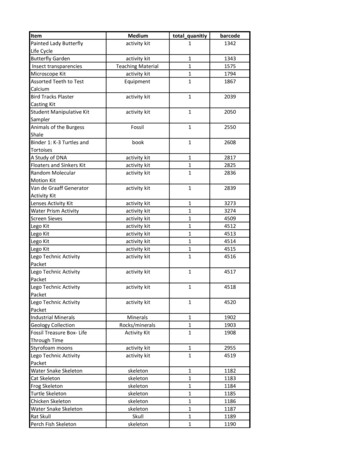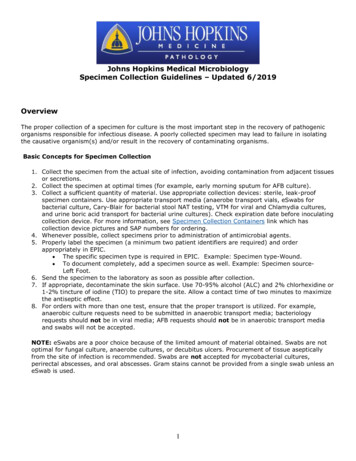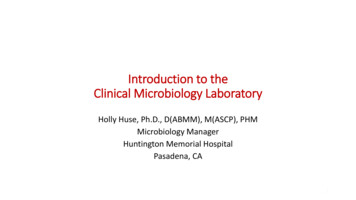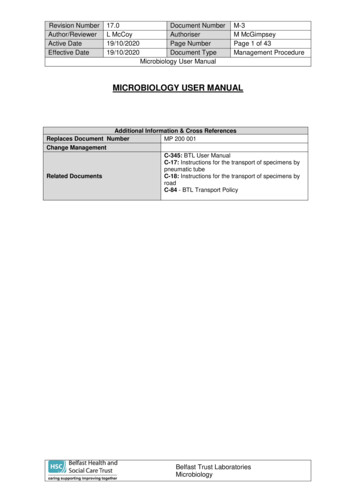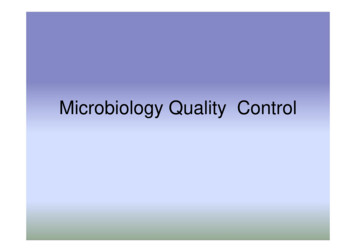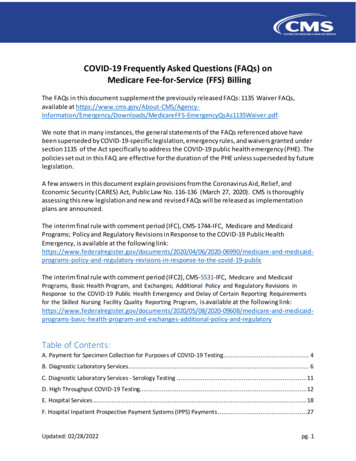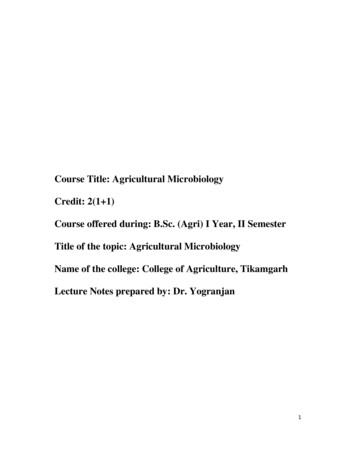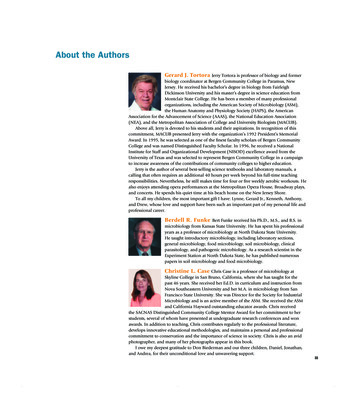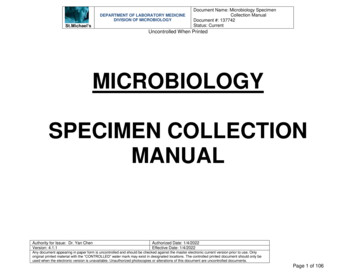
Transcription
DEPARTMENT OF LABORATORY MEDICINEDIVISION OF MICROBIOLOGYSt.Michael’sDocument Name: Microbiology SpecimenCollection ManualDocument #: 137742Status: CurrentUncontrolled When PrintedMICROBIOLOGYSPECIMEN COLLECTIONMANUALAuthority for Issue: Dr. Yan ChenVersion: 4.1.1Authorized Date: 1/4/2022Effective Date: 1/4/2022Any document appearing in paper form is uncontrolled and should be checked against the master electronic current version prior to use. Onlyoriginal printed material with the “CONTROLLED” water mark may exist in designated locations. The controlled printed document should only beused when the electronic version is unavailable. Unauthorized photocopies or alterations of this document are uncontrolled documents.Page 1 of 106
DEPARTMENT OF LABORATORY MEDICINEDIVISION OF MICROBIOLOGYSt.Michael’sDocument Name: Microbiology SpecimenCollection ManualDocument #: 137742Status: CurrentUncontrolled When PrintedMICROBIOLOGY LABORATORY - GENERAL INFORMATIONHOURS OF OPERATIONWeekdays08:30-22:00Weekends and Statutory Holidays08:00-16:00The microbiology laboratory will receive specimens 24 hours/7 days a week, but only select specimens will be planted during the overnight shift.For STAT Service after hours for Critical Specimens, please page the on call technologist through locating ext. 5431Critical Specimens: CSF Sterile Body Fluids e.g. vitreous/aqueous specimens, pleural fluid, joint fluid Operative specimens e.g. tissue, brain abscessLOCATIONCardinal Carter Wing, 2ndfloor - Room 2-044CONTACT INFORMATIONLaboratoryHead, Division of MicrobiologyClinical MicrobiologistMedical MicrobiologistMedical MicrobiologistManagerOperations LeaderTechnical SpecialistTechnologist on call through locating416-864-5381416-864-6060 ext. 2946 (Dr. Larissa Matukas)416-864-6060 ext. 3140 (Dr. Ramzi Fattouh)416-530-6000 ext. 6270 (Dr. Yan Chen)416-530-6000 ext. 4005 (Dr. Greg -5431REFERRAL OF SPECIMENS FOR TESTING TO EXTERNAL LABORATORIESAll specimens referred to external laboratories for microbiological testing must have the approval and participation of the Microbiology Laboratory.Authority for Issue: Dr. Yan ChenVersion: 4.1.1Authorized Date: 1/4/2022Effective Date: 1/4/2022Any document appearing in paper form is uncontrolled and should be checked against the master electronic current version prior to use. Onlyoriginal printed material with the “CONTROLLED” water mark may exist in designated locations. The controlled printed document should only beused when the electronic version is unavailable. Unauthorized photocopies or alterations of this document are uncontrolled documents.Page 2 of 106
DEPARTMENT OF LABORATORY MEDICINEDIVISION OF MICROBIOLOGYSt.Michael’sDocument Name: Microbiology SpecimenCollection ManualDocument #: 137742Status: CurrentUncontrolled When PCPPCRPHOLRTSAFSBESMHSTDTBVREAuthority for Issue: Dr. Yan ChenVersion: 4.1.1DESCRIPTIONCulture and SusceptibilityCerebral Spinal FluidCentral Venous PressureEthylenediaminetetraacetic acidExtended Spectrum Beta-LactamaseEndotracheal TubeFastidious Anaerobic BrothHospital Information SystemHuman Immunodeficiency VirusHospital for Sick ChildrenIntravenousLymphogranuloma VenereumLow Power FieldMethicillin Resistant Staphylococcus aureusNational Microbiology LaboratoryOperating RoomPneumocystis carinii pneumoniaPolymerase Chain ReactionPublic Health Ontario LaboratoryRoom TemperatureSodium acetate-Acetic acid-FormalinSubacute Bacterial EndocarditisSt. Michael’s HospitalSexually Transmitted DiseaseTuberculosisVancomycin Resistant EnterococciAuthorized Date: 1/4/2022Effective Date: 1/4/2022Any document appearing in paper form is uncontrolled and should be checked against the master electronic current version prior to use. Onlyoriginal printed material with the “CONTROLLED” water mark may exist in designated locations. The controlled printed document should only beused when the electronic version is unavailable. Unauthorized photocopies or alterations of this document are uncontrolled documents.Page 3 of 106
DEPARTMENT OF LABORATORY MEDICINEDIVISION OF MICROBIOLOGYSt.Michael’sDocument Name: Microbiology SpecimenCollection ManualDocument #: 137742Status: CurrentUncontrolled When PrintedSPECIMEN COLLECTION CONTAINERS/KITS SUPPLIED BY MICROBIOLOGY LABORATORYThe following specimen collection containers/kits can be obtained from the Microbiology Laboratory:COLLECTION CONTAINER/KITUSAGEM40 Transystem (Bacteriology transport swab)*eSwab Transport System (Bacteriology transport swab)**Pediatric (PF) blood culture bottleCollection of specimen for aerobic and anaerobic bacterial cultureCollection of specimen for aerobic and anaerobic bacterial cultureCollection of pediatric blood culture specimen or sterile fluidCollection of throat/pharyngeal, rectal, female vaginal orendocervical specimens for the detection of Chlamydia andNeisseria gonorrhoeae by PCR testing.Collection of specimen for Chlamydia/Mycoplasma/Ureaplasma/Viral cultureCollection of nasopharyngeal swab for influenza and COVID-19testingCollection of specimen for whooping coughCollection of stool for ova and parasitesCollection of stool for bacterial cultureCollection of specimen for detection of pinwormCollection of specimen for Trichomonas cultureCollection of eye specimens for bacterial culture and AcantamoebaCollection of nail/skin scrapings for fungal cultureRoche cobas PCR Media Dual Swab Sample KitCopan Universal Transport Media (UTM) for:Chlamydia/Mycoplasma/Ureaplasma/Viral cultureUniversal Transport Media (UTM) for: Influenza andCOVID-19Bordetella pertussis kitSAF containerCary Blair enteric transportPinworm paddle kitsDiamond’s mediaEye culture media for bedside inoculationBlack paper for fungus* M40 Transystem (Bacteriology transport swab) for out-patient locations is no longer available through SMH Logistic department (stores).** eSwab Transport System (Bacteriology transport swab) In-patients and out-patient locations must order their supply through SMH Logisticdepartment (stores).Please see Appendix A for examples of specimen collection containers and kits.Note: Aerobic plus (BACTEC Plus Aerobic/F), Anaerobic lytic (BACTEC Lytic 10 Anaerobic/F) and blood culture bottles are ordered and suppliedthrough SMH Logistic department (stores).The expiry date on all specimen containers/kits MUST be checked before use. Use of expired transport containers/kits may impair thesensitivity/specificity of the test and will result in the rejection of the specimen.Authority for Issue: Dr. Yan ChenVersion: 4.1.1Authorized Date: 1/4/2022Effective Date: 1/4/2022Any document appearing in paper form is uncontrolled and should be checked against the master electronic current version prior to use. Onlyoriginal printed material with the “CONTROLLED” water mark may exist in designated locations. The controlled printed document should only beused when the electronic version is unavailable. Unauthorized photocopies or alterations of this document are uncontrolled documents.Page 4 of 106
DEPARTMENT OF LABORATORY MEDICINEDIVISION OF MICROBIOLOGYSt.Michael’sDocument Name: Microbiology SpecimenCollection ManualDocument #: 137742Status: CurrentUncontrolled When PrintedSPECIMEN COLLECTION – GENERAL INFORMATIONSpecimens for microbiology analysis are likely to contain living organisms whose detection depends on rapid, professional specimenmanagement. Understanding this simple concept should motivate specimen collectors to do the following:1. Select the correct anatomic site from which to obtain the specimen.2. Send tissue or fluids to the laboratory rather than swabs wherever possible.3. Collect the specimen using the proper technique and supplies. Please see Appendix A for examples of different specimen collectioncontainers and kits. All specimens should be collected in accordance with Routine Practices and Transmission Based Precautions. Allspecimens are considered potentially infectious and should be handled as such. Dispose of any biohazardous waste as appropriate, i.e.needles in sharps container, biohazardous waste in biohazard bins4. Read collection instructions carefully. Improper specimen collection will result in the rejection of the specimen.5. The clinician, nurse, or phlebotomist must identify the patient and ensure consent has been obtained from the patient prior to collecting thespecimen. The person collecting the specimen must correctly identify the patient using two unique identifiers. Each specimen shall belabelled at the time and point of collection and in the presence of the patient with the patient’s full name (or unique code number, in thecase of anonymous testing) and one other unique identifier, such as the Medical Record Number or Date of Birth. Time and date must beadded for time sensitive specimens.Common time sensitive Microbiologic tests that require the date and time of collection are: Molecular tests Viral Load Viral Culture Chlamydia Culture Legionella Culture Bacterial Culture and Sensitivity Mycoplasma culture/PCR6. Package the specimen in the appropriate container designed to avoid leakage, which might pose a safety hazard and will result in therejection of the specimen. Containers often contain special transport media designed to promote survival of the causative organism.7. Place each specimen in a specimen transport bag with a pouch at the back of the bag. The specimen should be placed in the resealableportion of the bag and the requisition or specimen label should be placed in the pouch.Authority for Issue: Dr. Yan ChenVersion: 4.1.1Authorized Date: 1/4/2022Effective Date: 1/4/2022Any document appearing in paper form is uncontrolled and should be checked against the master electronic current version prior to use. Onlyoriginal printed material with the “CONTROLLED” water mark may exist in designated locations. The controlled printed document should only beused when the electronic version is unavailable. Unauthorized photocopies or alterations of this document are uncontrolled documents.Page 5 of 106
DEPARTMENT OF LABORATORY MEDICINEDIVISION OF MICROBIOLOGYSt.Michael’sDocument Name: Microbiology SpecimenCollection ManualDocument #: 137742Status: CurrentUncontrolled When PrintedSPECIMEN COLLECTION – GENERAL INFORMATION (continued)8. Provide complete order information through Soarian or using paper requisitions, ensuring that all required information (e.g. whom thespecimen is collected by, source and site of specimen, antibiotics given and clinical details) is provided. Soarian should be used to orderspecimens on in-patient units and Emergency Department. Paper requisitions are generally used in out-patient areas.9. Transport the specimen to the laboratory expeditiously or make sure that if it is stored, storage is brief, properly done, and at atemperature that will not damage the suspected organism.10. Specimens are routinely cultured to encompass retrieval of the widest range of potential pathogens recovered on routine bacteriologicalmedia. Organisms which require special nutrients/conditions must be specifically requested. Such organisms include: Parasites Mycobacterium tuberculosis (TB) Viruses Fungus Chlamydia B. pertussis (Whooping Cough) Mycoplasma/Ureaplasma Unusual bacterial pathogens such as Legionella, Helicobacter, Bartonella, Leptospira, Vibrio, Diphtheria, etc.11. Samples for Molecular Diagnostics, including polymerase Chain Reaction (PCR) and Viral Load have special documentation andtransportation instructions. This manual should be consulted before collecting a specimen for PCR or Viral Load.12. For blood specimen collection instructions please refer to St. Michael’s - Peripheral Venipuncture to Draw Blood Samples Policy.13. All Biomedical waste should be properly disposed of. Please refer to St. Michael’s - Procedure for Disposal of Biomedical Waste.14. For specimens that require testing performed by PHOL, please refer to Ontario Public Health’s Testing Directory Index for more information.15. For tests not listed in this manual, please consult the Medical Microbiologist on call via locating.Authority for Issue: Dr. Yan ChenVersion: 4.1.1Authorized Date: 1/4/2022Effective Date: 1/4/2022Any document appearing in paper form is uncontrolled and should be checked against the master electronic current version prior to use. Onlyoriginal printed material with the “CONTROLLED” water mark may exist in designated locations. The controlled printed document should only beused when the electronic version is unavailable. Unauthorized photocopies or alterations of this document are uncontrolled documents.Page 6 of 106
DEPARTMENT OF LABORATORY MEDICINEDIVISION OF MICROBIOLOGYSt.Michael’sDocument Name: Microbiology SpecimenCollection ManualDocument #: 137742Status: CurrentUncontrolled When PrintedCRITERIA FOR CULTURE OF ANAEROBESAnaerobes must be requested, if they are suspected.The following specimens are appropriate specimens for the culture of anaerobes: Surgical specimens/biopsies Aseptically taken needle aspirates Protected bronchial brushings Normally sterile fluid (e.g. joint fluid)The following specimens are unacceptable for the culture of anaerobes: Throat swabs Nasopharyngeal swabs Expectorated sputum/ETT Bronchial washings Voided urine Vaginal or cervical swabs (with the exception of post-partum specimens for Clostridia) Feces (except for C. difficile) Gastric and small bowel contents Ileostomy/colostomy effluents Large bowel contents, except for specific agents such as C. difficile Surface swabs from decubitus ulcers, peri-rectal abscesses, foot ulcers, exposed wounds, eschars, pilonidal sinuses Any material adjacent to a mucous membrane that has not been adequately decontaminated.REFERENCEJousimies-Somer, HR, Summanen, P Citron, DM et al: Anaerobic Bacteriology Manual, Sixth Edition. 2002. Star Publishing Company. Belmont,California, USAAuthority for Issue: Dr. Yan ChenVersion: 4.1.1Authorized Date: 1/4/2022Effective Date: 1/4/2022Any document appearing in paper form is uncontrolled and should be checked against the master electronic current version prior to use. Onlyoriginal printed material with the “CONTROLLED” water mark may exist in designated locations. The controlled printed document should only beused when the electronic version is unavailable. Unauthorized photocopies or alterations of this document are uncontrolled documents.Page 7 of 106
DEPARTMENT OF LABORATORY MEDICINEDIVISION OF MICROBIOLOGYSt.Michael’sDocument Name: Microbiology SpecimenCollection ManualDocument #: 137742Status: CurrentUncontrolled When PrintedSPECIMEN IDENTIFICATION AND INFORMATION POLICYThe Specimen Identification and Information Policy must be followed at all times.All specimens shall be uniquely labeled and accompanied by an electronic or paper requisition to which they are traceable.Each specimen shall be labeled at the time and point of collection and in the presence of the patient with the patient’s full name (or unique codenumber, in the case of anonymous testing) and one other unique identifier, such as the Medical Record Number or Date of Birth and the individualcollecting the specimen.Specimens lacking proper identification and the date and time (where applicable) of collection or an accompanying requisition shall not beprocessed, except if the specimen would be difficult or impossible to recollect or irretrievable.Authority for Issue: Dr. Yan ChenVersion: 4.1.1Authorized Date: 1/4/2022Effective Date: 1/4/2022Any document appearing in paper form is uncontrolled and should be checked against the master electronic current version prior to use. Onlyoriginal printed material with the “CONTROLLED” water mark may exist in designated locations. The controlled printed document should only beused when the electronic version is unavailable. Unauthorized photocopies or alterations of this document are uncontrolled documents.Page 8 of 106
DEPARTMENT OF LABORATORY MEDICINEDIVISION OF MICROBIOLOGYSt.Michael’sDocument Name: Microbiology SpecimenCollection ManualDocument #: 137742Status: CurrentUncontrolled When PrintedORDERING, IDENTIFYING AND LABELLING SPECIMENS USING SOARIAN1. Orders must be entered into Soarian after the specimen has been collected (generally, very close to the time of collection).2. Specimen type and site information must be provided to enable the appropriate culture tests to be performed.3. Any relevant clinical information (travel history, symptoms) or antibiotics given should be provided.4. Four labels will print with each order:a) Bar code label: Provides the patient’s name, age, gender, unit location position, MRN #, order#, lab test and collection containertypeb) HIS label: Hospital Information system label: This is not being used at this time. It can be discarded.c) Collected by Date and Time label: Used to sign name of person collecting the specimen and record date and time of specimencollection. This MUST be completed and placed in the outer pocket of the specimen bag.d) Summary label: A summary of all tests ordered. This should not be sent to the laboratory.5. Labels should be placed vertically and firmly attached to the body of the specimen containers. Labels should not be placed on the lid orcover any part of the lid.6. The label should not cover up any existing barcode labels or expiry dates e.g. Blood culture bottles7. Unused labels must be discarded in a secure container for shredding.8. If additional tests are required on a specimen already received in the laboratory, the clinical unit must call the laboratory to request theadditional test. Performance of add-on requests will depend on the availability and the suitability of the specimens. HIV tests cannot beadded verbally.Authority for Issue: Dr. Yan ChenVersion: 4.1.1Authorized Date: 1/4/2022Effective Date: 1/4/2022Any document appearing in paper form is uncontrolled and should be checked against the master electronic current version prior to use. Onlyoriginal printed material with the “CONTROLLED” water mark may exist in designated locations. The controlled printed document should only beused when the electronic version is unavailable. Unauthorized photocopies or alterations of this document are uncontrolled documents.Page 9 of 106
DEPARTMENT OF LABORATORY MEDICINEDIVISION OF MICROBIOLOGYSt.Michael’sDocument Name: Microbiology SpecimenCollection ManualDocument #: 137742Status: CurrentUncontrolled When PrintedORDERING, IDENTIFYING AND LABELLING SPECIMENS USING PAPER REQUISITIONS1. All requisitions shall contain the following information:a) Patient’s full nameb) Patient date of birthc) Gender of patientd) Patient location (Ward or Clinic)e) Encounter numberf) Physician’s nameg) Specimen type and specific anatomic culture siteh) Date and time of specimen collectioni) Test(s) requestedj) Clinical diagnosis, special culture request and relevant patient historyk) Antimicrobial agents, if any, that the patient is receiving.2. Each specimen should have a label firmly attached to the body of the container. Labels should not be placed on the lid or coverof the lid. All labels should contain the following informationa) Patient’ full nameb) Patient’s date of birthc) Gender of patientd) Medical record numbere) Locationf) Laboratory numberg) Culture site if multiple specimens collected.h) Collection Date and Timeany partNote: The minimum requirement for processing of any specimen must include the patient’s name (or code identifier) and at least oneother unique identifier. Expiry dates and existing bar code labels e.g. blood culture bottle should not be obscured by the patient label.3. If additional tests are required on a specimen already received in the laboratory, a new requisition must be generated and sent to thelaboratory with the indication that this is for an add-on test. Performance of add-on requests will depend on the availability and thesuitability of the specimen.Authority for Issue: Dr. Yan ChenVersion: 4.1.1Authorized Date: 1/4/2022Effective Date: 1/4/2022Any document appearing in paper form is uncontrolled and should be checked against the master electronic current version prior to use. Onlyoriginal printed material with the “CONTROLLED” water mark may exist in designated locations. The controlled printed document should only beused when the electronic version is unavailable. Unauthorized photocopies or alterations of this document are uncontrolled documents.Page 10 of 106
DEPARTMENT OF LABORATORY MEDICINEDIVISION OF MICROBIOLOGYSt.Michael’sDocument Name: Microbiology SpecimenCollection ManualDocument #: 137742Status: CurrentUncontrolled When PrintedCONSENT FORMS FOR HIV TESTING HIV antibody testing is the only test performed in Microbiology that requires consent in addition to the general consent obtained onadmission. Consent forms are available at the nursing station. Obtain a supply from the print shop. Completed consent forms are placed in the patient’s chart. Consent is indicated on the requisition by either a physician signature or by stating that consent has been obtained.Authority for Issue: Dr. Yan ChenVersion: 4.1.1Authorized Date: 1/4/2022Effective Date: 1/4/2022Any document appearing in paper form is uncontrolled and should be checked against the master electronic current version prior to use. Onlyoriginal printed material with the “CONTROLLED” water mark may exist in designated locations. The controlled printed document should only beused when the electronic version is unavailable. Unauthorized photocopies or alterations of this document are uncontrolled documents.Page 11 of 106
DEPARTMENT OF LABORATORY MEDICINEDIVISION OF MICROBIOLOGYSt.Michael’sDocument Name: Microbiology SpecimenCollection ManualDocument #: 137742Status: CurrentUncontrolled When PrintedSPECIMEN TRANSPORT All specimens must be transported in specimen transport bags. These are clear bags with a pouch in the back and are labeled as abiohazard. Only one specimen should be placed in each bag. Either the requisition or the Specimen Collection Label must accompany Microbiology specimens and should be placed in the pouch in theback of the specimen transport bags. Routine and Transmission Based Precautions must be followed when transporting specimens. STAT specimens must be immediately transported to the laboratory upon collection.The following specimens are always considered STAT:o HIV viral loado Hepatitis B DNAo Hepatitis C RNAo CSF from patients with suspected meningitis.o Source patient and exposed health care worker (baseline work up) in needle stick injuries All other specimens must be promptly transported to the laboratory, preferably within 2 hours of collection. If transport is delayed the specimen can be stored under the conditions specified in the specimen collection table. All specimens should arrive in the laboratory within 24 hours of collection. Specimens are delivered to the Microbiology Laboratory during hours of operation (see page 2 for receiving hours) After hours, routine specimens are stored in Microbiology receiving fridge or incubator. STAT specimens, blood cultures, sterile fluids andtissues are received by the technician on duty (24 hours coverage).Authority for Issue: Dr. Yan ChenVersion: 4.1.1Authorized Date: 1/4/2022Effective Date: 1/4/2022Any document appearing in paper form is uncontrolled and should be checked against the master electronic current version prior to use. Onlyoriginal printed material with the “CONTROLLED” water mark may exist in designated locations. The controlled printed document should only beused when the electronic version is unavailable. Unauthorized photocopies or alterations of this document are uncontrolled documents.Page 12 of 106
DEPARTMENT OF LABORATORY MEDICINEDIVISION OF MICROBIOLOGYSt.Michael’sDocument Name: Microbiology SpecimenCollection ManualDocument #: 137742Status: CurrentUncontrolled When PrintedSPECIMEN REJECTIONThe following specimens will be rejected: Unlabeled specimensMismatched specimen (name on requisition does not match name on specimen)Grossly leaking specimensSpecimen broken in transitSpecimens received in inappropriate collection containersSpecimens improperly collectedSpecimens not stored properly before delivery to the laboratoryNo collection date and time provided on time sensitive specimensSpecimens delayed in transit including: 24 hours for Clostridium difficile 24 hours for urine 4 hours for HBV-DNA and HCV-RNA 24 hours for HIV viral loads 48 hours for other specimensInappropriate specimen for the test(s) requested e.g. Stool sample for pinworm diagnosis instead of pinworm paddle/scotch tapepreparation.Inappropriate specimens for culture including: Foley catheter tips Tracheal swabs Penis swabs Axilla/groin swabs for MRSA screenInsufficient quantity of specimen to perform test(s) requested.Replaceable swabs with no site informationSpecimens received in expired transport kits.PHOL serology tests with no virus/test statedAuthority for Issue: Dr. Yan ChenVersion: 4.1.1Authorized Date: 1/4/2022Effective Date: 1/4/2022Any document appearing in paper form is uncontrolled and should be checked against the master electronic current version prior to use. Onlyoriginal printed material with the “CONTROLLED” water mark may exist in designated locations. The controlled printed document should only beused when the electronic version is unavailable. Unauthorized photocopies or alterations of this document are uncontrolled documents.Page 13 of 106
DEPARTMENT OF LABORATORY MEDICINEDIVISION OF MICROBIOLOGYSt.Michael’sDocument Name: Microbiology SpecimenCollection ManualDocument #: 137742Status: CurrentUncontrolled When PrintedCOLLECTION INSTRUCTIONSInstructions for patients who are requested to collect their own specimens are in Appendices B-L. All other specimens are to becollected by physicians, nurses, or other authorized personnel.Specimens should be collected and stored as indicated in the following tables:Table1.11.21.3Bacterial culture and susceptibility testingBacterial serologyBacterial PCRTable2.12.22.3Chlamydia CultureChlamydia SerologyChlamydia PCRTable3.03.1Fungus CultureFungus Serology and Antigen DetectionTable4.0Legionella Culture/Antigen Detection/SerologyTable5.0Mycobacterial Diagnostic TestsTable6.16.2Mycoplasma/Ureaplasma CultureMycoplasma PCRTable7.17.2Parasite ExaminationParasite Serology/PCRTable8.18.28.3Virus CultureVirus Serology, Antigen Detection and PCRSpecimen Guide for Common Viral syndromesTable9.0Requirements for Pediatric Specimen CollectionAuthority for Issue: Dr. Yan ChenVersion: 4.1.1Authorized Date: 1/4/2022Effective Date: 1/4/2022Any document appearing in paper form is uncontrolled and should be checked against the master electronic current version prior to use. Onlyoriginal printed material with the “CONTROLLED” water mark may exist in designated locations. The controlled printed document should only beused when the electronic version is unavailable. Unauthorized photocopies or alterations of this document are uncontrolled documents.Page 14 of 106
DEPARTMENT OF LABORATORY MEDICINEDIVISION OF MICROBIOLOGYSt.Michael’sDocument Name: Microbiology SpecimenCollection ManualDocument #: 137742Status: CurrentUncontrolled When PrintedTable 1.1 Bacterial Culture & Susceptibility inimum volumeTransportStorageTesting LimitsLocationofTestingAdditionalInstructions andCommentsTAT forNegativeReportSKIN AND SOFT TISSUE INFECTIONS – Levine’s Technique is recommended. See Appendix LAbscess(General)Remove surfaceexudates by cleaningwith Sterile saline andsterile gauze.Allow surface to drybefore takingspecimen.Aspirate abscess fluidand dispense intosterile screw capcontainer.Aspirate if possible orpass a swab deepinto lesion usingLevine’s Technique.See Appendix LAspirate if possible orpass a swab deepinto lesion usingLevine’s Technique.See Appendix L.(Open)(Closed)Tissue or fluid is alwayssuperior to a swabspecimen.If swab is used, place inM40 transystem/eSwab TransportSystemDry swabs not intransport medium willnot be processedunless they arereceived in thelaboratory within 1 hourof specimen collection.Sterile Container 2hr; RTRefrigerator48hrs/sourceSMH4 daysSterile Container/M40 transystem/eSwab TransportSystem 2hr; RTRefrigerator1/48hrs/sourceSMH4 daysSterile Container/M40 transystem/eSwab TransportSystem 2hr; RTRefrigerator1/48hrs/sourceSMH4 daysSwab –48hoursBite WoundTreat as an abscessAuthority for Issue: Dr. Yan ChenVersion: 4.1.1Tissue/Fluids – 4daysAuthorized Date: 1/4/2022Effective Date: 1/4/2022Any document appearing in paper form is uncontrolled and should be checked against the master electronic current version prior to use. Onlyoriginal printed material with the “CONTROLLED” water mark may exist in designated locations. The controlled printed document should only beused when the electronic version is unavailable. Unauthorized photocopies or alterations of this document are uncontrolled documents.Page 15 of 106
DEPARTMENT OF LABORATORY MEDICINEDIVISION OF MICROBIOLOGYSt.Michael’sDocument Name: Microbiology SpecimenCollection ManualDocument #: 137742Status: CurrentUncontrolled When tStorageTesting LimitsTypeGuidelinesvolumeSKIN AND SOFT TISSUE INFECTIONS – Levine’s Technique is recommended. See Appendix LRemove surfaceexudates by cleaningwith Sterile saline or0.5% chlorhexidine in70% alcohol. Allowsurface to dry beforetaking specimen.Aspirate the area ofSterileCellulitismaximum 15 tion with afine needle andsyringe.Draw a small amountof sterile saline intothe syringe andaspirate into a sterilescrew-cap tube.Cultures of drain fluidtend to be colonizedand do not provideuseful informationabout infectingSterile1/48hrs/sourceDrain Fluid 2hr; RTRefrigerato
Clinical Microbiologist 416-864-6060 ext. 3140 (Dr. Ramzi Fattouh) Medical Microbiologist 416-530-6000 ext. 6270 (Dr. Yan Chen) . Document Name: Microbiology Specimen Collection Manual Document #: 137742 Status: Current. DEPARTMENT OF LABORATORY MEDICINE Collection Manual . DEPARTMENT OF LABORATORY MEDICINE : Specimen of / / - or .
